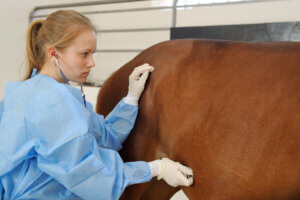Two Horse Diseases Subject to Official Control

Health authorities give special attention to two equine diseases in particular. These are the contagious equine metritis and the equine viral arteritis, and both are horse diseases subject to official control.
The fact that these diseases have greater relevance isn’t so much due to their mortality rate, but to the difficulties arising in managing the breeding specimens. That is, if a horse —either male or female— happens to be a carrier of these diseases, it’s difficult to use it as a breeding specimen.
This leaves many animals with unique genetic qualities out of the selection and breeding programs just because, during the examination, it turned out that they carried inadequate microorganisms.
Horse diseases subject to official control: contagious equine metritis
Contagious equine metritis appears as a mucopurulent vaginal discharge derived from uterine inflammation, which causes temporary infertility. In fact, mares can suffer more than one episode of this disease over a short period of time.
However, after the infection, most equines recover without problems. However, they can still become carriers of the pathogenic microorganism causing the disease (Taylorella equigenitalis).
Breeding males are the ones that usually transmit the infection during intercourse. Therefore, they act as carriers —the bacteria remain in their urogenital membranes— and spreaders of the infection.

Diagnosis
Lab analysis can detect bacteria from samples collected from the reproductive tracts of stallions and mares. These days, this test is mandatory prior to moving equines internationally.
The now-famous PCR tests are also frequently used for detection, as they prove to be very useful. Serological tests don’t allow for the reliable detection of the infection in order to adequately diagnose and control. These tests have failed even when used on females crossed with stallions suspected of being carriers.
Horse disease control program and health status
There are still no vaccines available to protect against this disease or to prevent the colonization with T. equigenitalis. For this reason, there are control programs that aim to include all breeding horses —both male and female. This control system has the following steps:
- Samples taken from the animal reach the laboratory for analysis.
- According to the result, the horse receives a health status regarding metritis.
- Depending on this status, the horse may or may not be suitable for breeding. Thus, contagion is avoided as much as possible by not breeding carrier specimens.
Horse diseases subject to official control: equine viral arteritis
In this case we’re dealing with a contagious disease caused by an Arteriviridae virus. Even if the spectrum of natural hosts of the virus seems restricted to equids, evidence shows that it also affects alpacas and llamas.
The symptoms of the disease aren’t very specific. The animal can experience fever, depression, anorexia, edema in the legs, scrotum and foreskin, conjunctivitis, nasal secretion and urticaria, among other clinical signs. Abortions may occur in females, and pneumonia and fulminant enteritis in young foals.
Fortunately, in most cases, the animal recovers completely once the symptoms pass. Records show that there are sequelae in the tissues due to the vasculitis —inflammation of the blood vessels— caused by the virus.
Some stallions become can chronically carry the virus in their reproductive system, and can excrete it with their semen. This relates to the presence of androgens, as it’s not present in mares, castrated horses, or sexually immature foals.
Contagion
The spreading of the virus can occur by respiratory, sexual, or congenital transmission. Sexual transmission is the most important for health authorities, as it has the greatest potential to be prevented.
Diagnosis
We must differentiate this disease from many others that affect the respiratory system or cause common symptoms. This is the case of horse flu, equine rhinitis or African horse sickness. That’s why all kinds of analyses are performed in order to differentiate some pathogens from others.
The PCR test can identify the arterivirus from tissue samples and secretions. This serves to confirm, as well as to rule out, the infection. Consequently, it’s very useful when transporting animals.
The use of serological tests is also useful when examining suspect cases of abortion, and death in young foals or older horses. Unfortunately, only a few tests offer sufficient sensitivity and specificity.
Horse disease control programs, health status, and vaccination
The incidence of this disease has increased in recent years due to increased horse movement and the use of seminal doses. Therefore, the aim of the control program is to prevent the spread of the virus among breeding animals. As a result, the risk of abortions and deaths in young foals will decrease.

These programs are based on best management practices and vaccination for males, reproductive females, and sexually immature foals. There are currently two vaccines against the virus available on the market, one in North America and another in Europe. Both aim to prevent outbreaks, with special attention to abortion in mares.
All horses intended for breeding will be subject to the control program. This control will include the collection of samples and their analysis in order to determine the horse’s health status. Thus, breeding will be allowed according to the result.
All cited sources were thoroughly reviewed by our team to ensure their quality, reliability, currency, and validity. The bibliography of this article was considered reliable and of academic or scientific accuracy.
- Metritis Contagiosa Equina [Internet]. Mapa.gob.es. [cited 8 October 2020]. Available from: https://www.mapa.gob.es/es/ganaderia/temas/sanidad-animal-higiene-ganadera/sanidad-animal/enfermedades/metritis-contagiosa-equina/Metritis_C_Eq.aspx
- Metritis contagiosa equina. Manual Terrestre de la OIE [Internet]. Oie.int. 2018 [cited 8 October 2020]. Available from: https://www.oie.int/fileadmin/Home/esp/Health_standards/tahm/3.05.02_Metritis_contagiosa_equina.pdf
- Arteritis Viral Equina [Internet]. Mapa.gob.es. [cited 8 October 2020]. Available from: https://www.mapa.gob.es/es/ganaderia/temas/sanidad-animal-higiene-ganadera/sanidad-animal/enfermedades/arteritis-viral-equina/Arteritis_v_equina.aspx
- Arteritis vírica equina. Manual Terrestre de la OIE [Internet]. Oie.int. 2018 [cited 8 October 2020]. Available from: https://www.oie.int/fileadmin/Home/esp/Health_standards/tahm/3.05.10_EVA.pdf
- Andrógeno [Internet]. Es.wikipedia.org. [cited 8 October 2020]. Available from: https://es.wikipedia.org/wiki/Andr%C3%B3geno#:~:text=Los%20andr%C3%B3genos%20son%20hormonas%20sexuales,de%20los%20caracteres%20sexuales%20masculinos.
- Edema [Internet]. Es.wikipedia.org. [cited 8 October 2020]. Available from: https://es.wikipedia.org/wiki/Edema#:~:text=El%20edema%20(o%20hidropes%C3%ADa)%20es,de%20las%20cavidades%20del%20organismo.
- Reacción en cadena de la polimerasa [Internet]. Es.wikipedia.org. [cited 8 October 2020]. Available from:
- https://es.wikipedia.org/wiki/Reacci%C3%B3n_en_cadena_de_la_polimerasa
